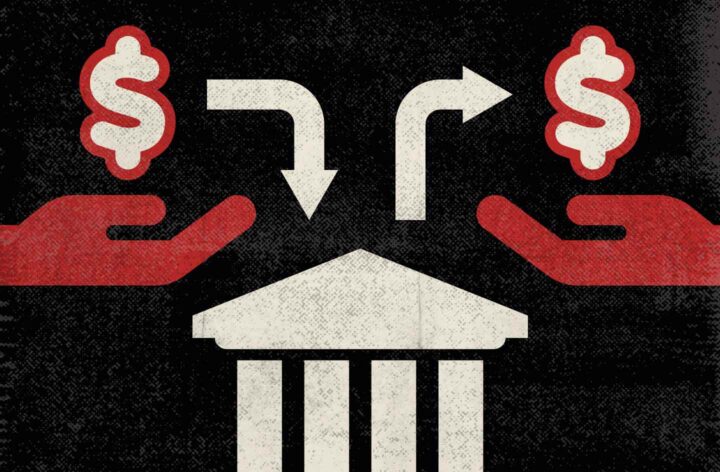What Is Crypto Lending?

Cryptocurrency lending is one of the most popular ways of passive capital growth. The essence is that the user lends their digital assets to other users or sites and receives interest payments. Essentially, lending is an analog of classic loans, using cryptocurrencies, and offering different peculiarities. Let’s consider what types of crypto lending exist and what platforms provide it.
Types of Cryptocurrency Lending

The DeFi sector emerged with the development of blockchain technology. One of its areas is cryptocurrency lending. By sending funds to lending, investors can:
- Sponsor margin trading on cryptocurrency exchanges.
- Provide funds to crypto lending platforms;
- Secure liquidity for specific assets.
The volume of funds involved in lending schemes has decreased slightly due to the ongoing bearish trend in the market, but it’s still quite substantial. For example, the DAI lending protocol exceeds $6.8 billion as of October 6, 2022, as evidenced by The Block, where you can find other interesting figures on lending volume and profitability.
Lending boils down to users lending their assets as credit funds to other users for a certain period of time at a certain interest, using a decentralized protocol based on smart contracts. The process is also mediated through centralized platforms, even though lending refers to the DeFi sector. In any case, the essence of the process remains the same, but the specifics of such lending may differ in detail.
Margin Trading on Crypto Exchanges

Almost any major trading platform offers the opportunity to send funds to lending. The platform provides traders with margin leverage of these funds — a certain amount of crypto used for trading. If the trade’s successful, the trader can make additional profits, and the lending platform recovers the borrowed funds.
The amount of leverage and fees depend on the terms and conditions of the specific cryptocurrency platform. The user’s initial transaction amount is used as collateral — it’s multiplied by the leverage ratio, which can be x3, x10, x20, or more, using lending funds. In case of a successful transaction, the user is charged a commission of 0.05% to 1% of the amount given for trading.
If the trading position turns out to be unprofitable, the platform sends the user a margin call — a special message warning about the current loss. Subsequently, the platform may automatically close trading positions to recover the margin call amount. In such a case, the user loses their funds.
Moreover, crypto platforms receive commission payments from all trading operations, regardless of the success of these operations for traders.
P2P Lending Platforms

The classic type of crypto lending platforms is decentralized P2P lending protocols, where other crypto-assets serve as collateral. As a rule, users set their own credit offers, a fixed interest rate, and the required amount of collateral.
Users wishing to obtain such a loan search for the most suitable offer and execute the transaction. Everything works via smart contracts. Users should only entrust their funds to those protocols that have been audited for security by reputable offices.
Investing in Lending Programs

Some cryptocurrency platforms and services act as a centralized intermediary in crediting other users through lending. These platforms use smart contracts or internal algorithms to lend digital assets to other users, guaranteeing depositors a certain percentage of income.
It’s worth considering that the number of scam projects in the crypto space grows in proportion to its popularity. Therefore, investors should carefully study the chosen platform, security audits, the team, reviews, and the terms and conditions of the offered program before investing in a “highly profitable” lending protocol.
Hybrid Loans

This type of lending involves the following feature. The user takes a loan in fiat funds, the amount of which is tied to the current rate of the cryptocurrency asset. BTC acts as the most popular asset in this context. For instance, the user lends $100, equivalent to 0.0001 BTC at the moment of lending. If BTC’s value changes by the time the loan is due, the user will still have to pay back the dollar equivalent of 0.0001 BTC.
It works the other way around when you take a loan in crypto but in the equivalent of its fiat value. Such mechanics resemble long and short positions in trading. However, the point doesn’t change for the investor — they provide a certain amount to lending and receive interest for its use.
Pros and Cons of Crypto Lending

Lending is characterized by the same advantages and disadvantages as other investments in DeFi projects. The main benefits include the following:
- automation of processes;
- high return on investment;
- the speed and relative simplicity of the process;
- flexibility, a wide range of investment options;
- an active community, ready to help with advice.
The potential drawbacks are also typical:
- the risk of investing in a fraudulent project;
- the likelihood that hackers will take advantage of vulnerabilities in the protocol;
- tokenomics problems with the protocol and FUD attacks, which can affect its stability and performance.
The high volatility of crypto-assets should also be considered since it can be a plus or a minus. It’s important to remember that DeFi projects are always extremely risky investments.
Crypto Lending Platforms

Crypto lending is available on many different cryptocurrency platforms. Here are some of them:
- Nexo. This is a centralized platform that supports transactions with over 30 crypto-assets and fiat currencies: USD, GBP, and EUR. Depositors are offered an average annual rate of 8%. Lloyd’s of London and BitGo serve as loan custodians. During the ten years of its existence, the site has processed applications for more than $700 million, and its audience exceeds 250,000 users.
- Binance Lending. The Binance ecosystem platform supports transactions in BTC, DASH, ETC, ZEC, LTC, BNB, and other crypto-assets. The annual interest rate for BNB lending is 15%, 10% for USDT, and 7% for other digital assets. The interest rates are relevant at the time of writing and may change.
- Coincheck Lending. BTC, NEM, ETH, XRP, and other crypto-assets are available for lending through the platform. The annual interest rate is up to 5%.
There are a lot of platforms and protocols that enable cryptocurrency lending. Aave, Compound, and Anchor are among the other major lending sites.
Crypto lending and the whole DeFi sector have become increasingly popular. The former is a promising type of passive income with possible risks, however, its potential benefits for many crypto investors prove to be weightier.











